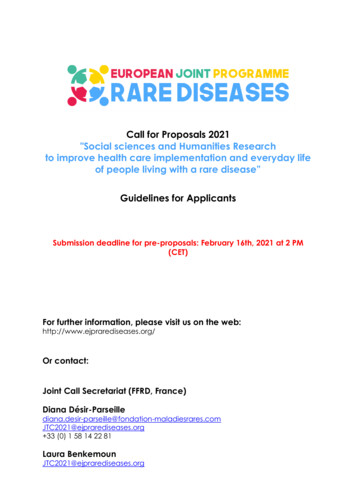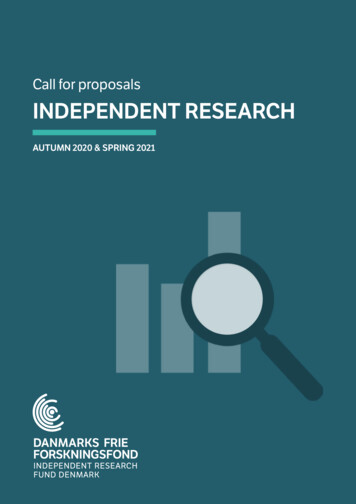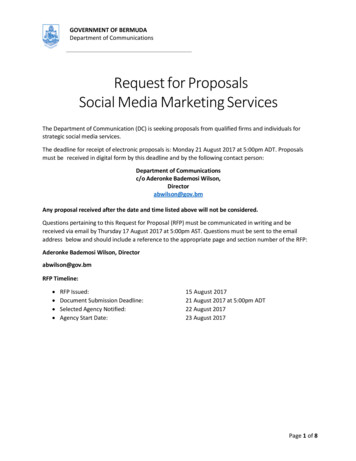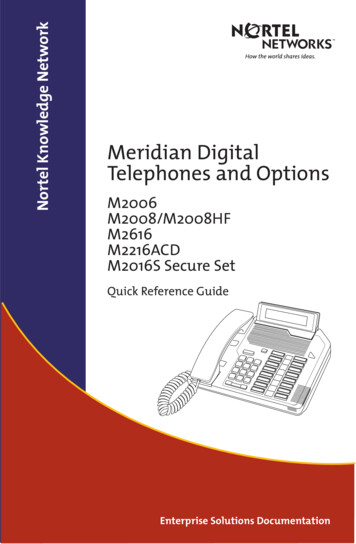
Transcription
Call for Proposals 2021"Social sciences and Humanities Researchto improve health care implementation and everyday lifeof people living with a rare disease”Guidelines for ApplicantsSubmission deadline for pre-proposals: February 16th, 2021 at 2 PM(CET)For further information, please visit us on the web:http://www.ejprarediseases.org/Or contact:Joint Call Secretariat (FFRD, France)Diana ladiesrares.comJTC2021@ejprarediseases.org 33 (0) 1 58 14 22 81Laura BenkemounJTC2021@ejprarediseases.org
GUIDELINES1. Application Process . 31.1 Registration . 31.2 Pre- and Full Proposals . 31.3 Rebuttal stage . 32. Advice for preparing your proposal. 33. Project description . 44. Early Career Researchers (ECRs) . 64.1 Definition . 64.2 Eligibility of ECRs . 75. Financial and Legal Issues . 85.1 Funding model and Call governance . 85.2 Widening for the inclusion of under-represented or under-subscribed countries 85.2.1 Definition of widening . 85.2.2 Process . 85.3 Funding contracts . 95.4 Project start and consortium agreement . 95.5 Ownership of intellectual property rights . 105.6 IRDiRC policies and guidelines. 115.7 European and International standards . 115.8 Publication of Results . 116. General Data Protection Regulation . 127. PAOs funding conditions . 13ANNEX 1: Country and Region-Specific Guidelines . 16AUSTRIA, FWF . 16BELGIUM, FWO . 18BELGIUM, F.R.S.-FNRS . 20CANADA, CIHR-IG . 22Estonia, MoSAE . 24FRANCE, ANR . 26GERMANY, BMBF/PT-DLR . 27HUNGARY, NKFIH . 30ISRAEL, CSO-MOH . 32ITALY, MoH-IT . 32Tuscany Region, Italy . 34Lithuania, LMT . 36LUXEMBOURG, FNR . 37POLAND, NCBR . 40Slovakia, SAS . 41Spain, ISCIII . 44Switzerland, SNSF . 47Turkey, Tubitak . 49INSERM, France is responsible for administering the funding of PAOs . 51
GUIDELINES1. Application Process1.1 RegistrationResearch consortia who intend to submit a transnational project proposalshould register as soon as possible via the electronic proposal system:https://ptoutline.eu/app/ejprd21. Please fill in the data sheet in the system. Thesame data sheet can be used for the submission of pre-proposals and fullproposals (if invited).1.2 Pre- and Full ProposalsThere will be a two-stage submission procedure for joint applications: a preand full proposal stage. In both cases, one joint proposal document (in English)shall be prepared by the partners of a joint transnational proposal and must besubmitted by the coordinator only to the JCS via the electronic submissionsystem: https://ptoutline.eu/app/ejprd21. Proposals must be prepared usingthe templates provided on the EJP RD web page (www.ejprarediseases.org).Proposals not conforming to template instructions (including length andformat) will be rejected.You will not need to submit a paper version of your proposal; however, boththe electronic pre-proposals and full proposals need to be signed (electronicsignature or a scanned copy of the signature page will be accepted).Joint pre-proposals (in English) must be received by the JCS in an electronicversion no later than February 16th, 2021 at 2:00 p.m. Central European Time(CET).Full proposals (in English) must be received by the JCS in an electronic versionno later than June 15th, 2021 at 2:00 p.m. Central European Summer Time (CEST).1.3 Rebuttal stagePlease note that project coordinators will be provided with the opportunity tostudy the assessments of external reviewers and comment on their evaluationsof full proposals (for details see section 7.3 in the “Call text” document).2. Advice for preparing your proposalCarefully read the “Call Text” and this “Guidelines for Applicants” document,including the call aim, evaluation criteria and national eligibility criteria andrequirements.Proposals not conforming to the following may be rejected without review:
Guidelines 2021 Make sure that your proposal falls into the scope of the call (Section 4 of thecall text)Make sure that your proposal fulfils the eligibility criteria of the call (Section 5 ofthe call text)Make sure that all consortium members have understood the national eligibilitycriteria and requirements (Annex 1) and that they fulfil these criteriaMake sure that all consortium members contacted their national representativeand confirmed eligibility with their respective funding organisations in advanceof submitting an application (see Annex 1)Prepare your proposal in advance and enter the requested information on thesubmission site as soon as possible to avoid possible overloading on thesubmission deadlinesUse the proposal templates provided on the EJP RD website(www.ejprarediseases.org)Respect the length limitations of each section in the proposals3. Project descriptionApplicants will describe and justify the following elements:The elements marked with a “*” will have to be developed only for full proposalsBackground, present state of the art in the SSH research field-Need for research rationale: description of the unmet need that is addressedby the proposed work, rationale of the rare diseases chosenPresent state of the art, recent insight from literaturePreliminary results obtained by the consortium membersObjectives and hypothesis-SSH research questionMain and secondary hypothesisSoundness and pertinence-Innovative aspects, originality, noveltySocial care and public health interestApplicants should include information about other ongoing developmentwork and explain why their approach should be supported*.Workplan & methodology (highlighting feasibility)-Research strategy, study type (see section 4.4)SSH methodologies justification and presentationEnrollment: study location(s), inclusion/exclusion criteria, total number ofcorresponding patients followed by partners and collaborators of the project.Number of participants calculation (if applicable): description, justification,expected response rate.Statistical power (if applicable): appropriate statistical methods description,name and affiliation of the responsible biostatistics’ expert.*Quality monitoring: risk management, contingency plans (identification ofpossible bottlenecks and go/no go steps).Impact4
Guidelines 2021-Results: description of expected results and their implementationImpact: description of the potential impact of the expected results on theaddressed unmet needBenefits: description of individual and collectives benefits that could beexpected*Valorization--Effective measures to exploit and disseminate the project results, tocommunicate the project, and to manage research datao Present / future position with regard to intellectual property rights, bothwithin and outside the consortiumo Scientific communication (articles, presentations ): description of plan,tools and responsibilities for communication towards clinical and SSHcommunityo PAO/Public communication: description of plan, tools andresponsibilities for communication towards PAOs, patients, anyconcerned peopleInnovative potential: relevant application for rare diseases care: possibleactions in social, health and/or socio-economic careTranslatability: opportunities to exploit the methodology and/or expectedresults for other rare and non-rare diseasesSustainability: description of plan for sustainability of infrastructures or resourcesinitiated by the project, follow-on funding and/or draft study plans past thegrant end, articulation with other existing research infrastructures**.*Ethical and legal issues, data management--Ethical and legal issues management plan description, including:o the recruitment of participants (e.g. direct/indirect incentives forparticipation, the risks and benefits for the participants etc.)o the material collection (e.g. sensitive or personal data etc.)o ensuring the wellbeing of the children involvedo ensuring consentSee H2020 Guidance “How to complete your ethics self-assessment” thatcan be found a/ref/h2020/grants manual/hi/ethics/h2020 hi ethics-self-assess en.pdfGDPR management: plan description, name and affiliation of the DataProtection Officer (DPO).Data management strategy: plan description to make research datafindable, accessible, interoperable and re-usable (FAIR).Work packages, timeline and budget-Description of the aims/work packages: synopsis and timeframe, includingproject coordination and management as well as *innovation managementactivities*Scientific justification of requested budget: rational distribution of resources inrelation to project’s activities, partners responsibilities and time frame; pleasealso specify co-funding from other sources necessary for the project ifapplicable5
Guidelines 2021-Diagram which compiles the work plan, timeline, sequencing of workpackages, contribution of the partners to each work package and theirinteractions (Gantt chart, Pert or similar)Responsibilities and workloads-For each research partner: competence and experience in the field(s) of theproposal (previous work in the field, specific expertise); responsibilities in eachwork package; *ongoing or submitted research grants.For PAO/patient representative: role and contribution, access to andengagement of patients, responsibilities in each work package.Added values: complementarity of the participants within the consortium,benefit of transnational collaboration*Management plan: operating and coordination methods*Those elements will have to be developed only for full proposals**The use of existing European health research infrastructures and/or IRDiRC recognizedresources is strongly encouraged when appropriate: e.g. research infrastructuresestablished as a European Research Infrastructure Consortium (ERIC) or identified on theroadmap of the European Strategy Forum on Research Infrastructures (ESFRI). Projects areinvited to identify the existing European research data infrastructures that may be usedand how these may be mobilized, in particular for long-term data curation andpreservation, when needed (in accordance with EU and IRDiRC recommendations).The following ESFRI European Research Infrastructures and European/international projectsor their results may be of use to consortia: ECRIN European Clinical Research Infrastructure Network EATRIS European Infrastructure for Translational Medicine IRDiRC recognized resources Horizon 2020 FAIR Data Management Plan Annex 14. Early Career Researchers (ECRs)4.1 DefinitionECRs are defined as per the regulations of the European Research Councilcriteria for starting grants. In short, the researcher must have been awardedtheir first doctoral degree (PhD) two to seven years prior to the pre-proposalsubmission deadline. Extensions to this period are allowed (withdocumentation) in the case of reasonably justified career breaks: absence formaternal, paternal or long-term sick leave, and compulsory military service.For medical doctors (or applicants holding a degree in medicine), an MD is notby itself considered equivalent to a PhD award. To be considered an ECR, theseapplicants must provide the certificates of both a medical doctor degree anda PhD, or proof of an appointment that requires doctoral equivalency (e.g.post-doctoral fellowship or professorship appointment). MD applicants that donot hold a PhD must have been awarded their MD four to nine years prior tothe pre-proposal submission deadline. For medical doctors who have been6
Guidelines 2021awarded both an MD and a PhD, the date of the earliest degree that makesthe applicant eligible will be used to calculate eligibility. Extensions to thisperiod will be given (with documentation) for clinical training periods up to amaximum of four years.4.2 Eligibility of ECRsThe following dates must be provided by Early Career Researchers so that theireligibility can be evaluated according to their respective regional/nationalregulations. This information must be present in the CV in the pre- and fullproposal forms.Medical doctors with PhDMedical Studies: indicate dates (start and end) of your studies (year andmonth)End of studies: indicate date of your medical certificatePhD Time: indicate dates (start and end) of your PhD time (year and month)PhD: indicate date of your PhD certificateAppointment: indicate dates (start and end) of the appointment that requiresdoctoral equivalency (e.g. post-doctoral fellowship or professorshipappointment), only if applicableMedical doctors without PhDMedical Studies: indicate dates (start and end) of your studies (year andmonth)End of studies: indicate date of your certificateAppointment: indicate dates of the appointment that requires doctoralequivalency (e.g. post-doctoral fellowship or professorship appointment)Other Early Career Scientists with PhDStudies: indicate dates (start and end) of your studies (year and month)End of studies: indicate date of your certificatePhD Time: indicate dates (start and end) of your PhD time (year and month)PhD: indicate date of your PhD certificateOther Early Career Scientists without PhDStudies: indicate dates (start and end) of your studies (year and month)End of studies: indicate date of your certificateAppointment: indicate dates of the appointment that requires doctoralequivalency (e.g. post-doctoral fellowship or professorship appointment)Reasons for Extensions, if applicableClinical Training: indicate dates (start and end) of clinical training (year andmonth)Parental leave: Women: number of children (1.5 years are given per child; incase of longer maternal leave, please indicate the exact dates); Men: indicateexact dates of paternal leave (per child)7
Guidelines 2021Career Break: indicate dates (year and month) of other career breaks: longterm sick leave, compulsory military service, carer’s leave5. Financial and Legal Issues5.1 Funding model and Call governanceThe EJP RD JTC 2021 Funding Partners have agreed to launch a joint call usingthe “virtual common pot” funding mode. This means that national/regionalfunding will be made available through national/regional fundingorganisations according to national/regional funding regulations. In addition,the EC will provide funding for Patient Advocacy Organisations (PAOs) thatcannot be funded by their respective national/regional funding organisations.This funding will be administrated by Inserm, France (see Annex 1).FFRD (France) is acting as Joint Call Secretariat (JCS) to assist the Call SteeringCommittee (CSC), and the national/regional funding bodies during theimplementation of the call.The JCS will be responsible for the administrative management of the call. It willbe the primary point of contact referring to the call procedures between theresearch consortia, the funding organisations (CSC), and the peer reviewers.The project coordinator will be the point of contact for the JCS during theapplication procedure and is responsible for forwarding this information toother partners.CSO-MOH (Israel) and FNRS (Belgium) will be responsible for the follow-upphase until the funded research projects have ended.5.2 Widening for the inclusion of under-represented or undersubscribed countries5.2.1 Definition of wideningFor proposals invited to the full proposal stage, there will be a widening step toprovide the opportunity to add partners to the consortium (up to a maximumtotal of 8, see section 5.4 Consortium Makeup of the Call Text). This step willallow for the addition of partners from participating countries that are usuallyunderrepresented in the call, as well as those undersubscribed (countrieswithout any selected applicants for the 2nd stage). This inclusion will not beconsidered as a fundamental change between pre- and full proposal.Inclusion of new research teams is not mandatory. The new teams includedshould bring an added value and expertise to the projects.5.2.2 ProcessA list of countries eligible for this widening procedure will be published on theEJP RD website after completion of the 1 st stage of evaluation and sent to thecoordinators that are invited to write a full proposal.8
Guidelines 2021The relevant national funding agencies may produce a list of research teamsthat could provide additional expertise to projects. For this, the title, preproposal abstract, and composition of the consortium will be shared withpotentially interested research teams. The JCS will then provide this list to thecoordinators of projects invited to the full proposal stage and give them theoption of adding them to the existing consortium.The coordinator/partners of projects invited to the 2nd stage of evaluation canalso inquire themselves about suitable partners from among listed countries.The new prospective partner must then contact their national funding agencyto confirm their eligibility.In all cases, the final decision on whether to take a new research team onboard will be taken by the project consortium. The rules concerning themaximum number of partners in a consortium and the maximum of tworesearch teams per country must still be respected. Furthermore, the newresearch team must be eligible for the national funding agency. For entedorundersubscribed countries may indicate that only national research teams thatwere already involved in pre-proposals (and thus are eligible) are allowed tomake use of this widening step.5.3 Funding contractsEach project includes several partners (including a project coordinator) asbeneficiaries. Each partner will have a separate funding contract/letter of grantwith their respective national/regional funding organisations, and according totheir regulations.Changes to the composition of research consortia or budget cannot occurwithin the contract/letter of grant without thorough justification. Minor changeswill be handled by the relevant national/regional funding agency. In the caseof major changes, an independent expert may be consulted to help with thefinal decision of the funding organisations. Research partners must inform theJCS and the respective funding bodies of any event that might affect theimplementation of the project.5.4 Project start and consortium agreementConsortium members of projects selected for funding must fix a commonproject start date, which will be the reference date for yearly and final reportsand extensions. This common project start date must appear in the ConsortiumAgreement (CA).The project consortium partners must sign a CA for cooperation. For referencesee the DESCA 2020 Model Consortium Agreement. It is recommended that theCA be signed by all relevant parties before the official project start date. Pleasenote that national/regional regulations may apply concerning the requirementfor a CA (please contact your national/regional contact point or check Annex9
Guidelines 20211). This consortium agreement must be made available on request to therelevant EJP RD JTC 2021 funding organisations.The purpose of the CA shall be: to underpin the collaboration and provide research partners with mutualassurance on project management structures and procedures, and their rightsand obligations towards one anotherto assure the CSC that the research consortium has a satisfactory decisionmaking capability and is able to work together in a synergistic mannerThe following subjects should be addressed by the CA (at minimum): purpose of and definitions used in the CAnames of organisations involvedcommon start date of the research projectorganisation and management of the projectrole and responsibilities of the research consortium coordinator and theresearch partners: person in charge, their obligations and key tasks, conditionsfor their changedeliverables (transnational reports and, if relevant, requirements for nationalreports where coordination is required)resources and fundingconfidentiality and publishingintellectual property rights (how this issue will be handled between researchpartners)decision making within the consortiumhandling of internal disputesthe liabilities of the research partners towards one another (including thehandling of default of contract)evolution of the consortium (renewal or end of the consortium, amendments)5.5 Ownership of intellectual property rightsResults and new Intellectual Property Rights (IPR) resulting from projects fundedthrough the EJP RD JTC 2021 will be owned by the beneficiaries’ organisationsaccording to national/regional rules on IPR. In the case of joint developmentof intellectual property, consortium partners will resolve this issue internally usingtheir consortium agreement and relevant legal guidelines and taking intoaccount their relative contributions.The results of the research project and IPR created should be actively exploitedand made available for use, whether for commercial gain or not, in order forpublic benefit to be obtained from the knowledge created, in the respect ofEuropean law on State aid for research and development.The funding organisations shall have the right to use documents, informationand results submitted by the research partners and/or to use the informationand results for their own purposes, provided that the owner’s rights are keptand taking care to specify their origin.10
Guidelines 20215.6 IRDiRC policies and guidelinesThe project partners are expected to follow IRDiRC policies and guidelines.5.7 European and International standardsThe submitted proposals must respect relevant European and internationalstandards including: H2020 ethics manual for research projectsThe Declaration of Helsinki Ethical Principles for Medical Research InvolvingHuman SubjectsThe General Data Protection Regulation (GDPR): the European Regulation (EU)2016/679 on the protection of natural persons with regard to the processing ofpersonal data and on the free movement of such 5ed71a1/language-en)European Research Council Guidelines on Implementation of Open Access toScientific Publications and Research DataTo make research data findable, accessible, interoperable and re-usable(FAIR), a data management strategy is mandatory in the full proposal. Examplequestions for a data management strategy.General ethical and legal requirements: Ethics is an integral part of research.Ethics should be embedded in the research and considered from the outset,and although legal and regulatory considerations may vary across differentcountries, EJPRD will only fund proposals which comply with national andinternational ethical standards, rules and legislations.International Ethical Guidelines for Biomedical Research Involving HumanSubjects CIOMS-WHO (2016)Oviedo Convention and its Additional Protocol on human rights andbiomedicine, concerning biomedical research (2005)COUNCIL OF EUROPE COMMITTEE OF MINISTERS. Recommendation CM/Rec(2016)6 of the Committee of Ministers to member States on research onbiological material of human origin (Adopted by the Committee of Ministers on11 May 2016).5.8 Publication of ResultsEach beneficiary must ensure open access (free of charge, online access forany user) to all peer-reviewed scientific publications relating to their results, ifthis is compliant with national/regional funding regulations.Funding recipients must ensure that all outcomes (publications, etc.) oftransnational EJP RD projects include a proper acknowledgement of EJP RDand the respective national/regional funding partner organisations. Thisincludes the display of the EJP RD logo when possible.Unless the EC requests or agrees otherwise or unless it is impossible, anydissemination of results (in any form, including electronic) must:1. display the EU emblem and11
Guidelines 20212. include the following text: “This project has received funding from the EuropeanUnion’s Horizon 2020 research and innovation programme under the EJP RDCOFUND-EJP N 825575”.When displayed together with another logo, the EU emblem must haveappropriate prominence. For the purposes of the obligations under this Article,the beneficiary may use the EU emblem without first obtaining approval fromthe Agency. This does not however give it the right to exclusive use. Moreover,the beneficiary may not appropriate the EU emblem or any similar trademarkor logo, either by registration or by any other means.6. General Data Protection RegulationThe following Data Privacy Notice appliesBy submitting an application to the co-funded call JTC2021, applicants consentto the use, processing and retention of their data for the purposes of: processing and evaluating the application where processing shall be lawfulonly if and to the extent that processing is necessary for the performance of atask carried out in the public interest or in the exercise of official authority vestedin the controller;administering any subsequent funding award;managing the Funding Party’s relationship with them;analysing and evaluating the call;reporting to the European Commission/ Research Executive Agency (REA) onthe Co-funded call;providing aggregate data to national and European surveys and analyses;complying with audits that may be initiated by the Funding Parties and theEuropean Commission (or its agencies).The members of the EJP RD consortium may share an applicant’s data withthird parties (some of which may be based outside the European EconomicArea) in relation to the above activities including evaluators, auditors and theEuropean Commission (or its agencies).The members of the EJP RD consortia may link the data that applicants providein the application with national, bibliographic or external research fundingdata which is available through public subscription-based databases (e.g.Scopus, Web of Science, etc.) or other national / open datasets. The membersof the EJP
the electronic pre-proposals and full proposals need to be signed (electronic signature or a scanned copy of the signature page will be accepted). Joint pre-proposals (in English) must be received by the JCS in an electronic version no later than February 16th, 2021 at 2:00 p.m. Central European Time (CET).










